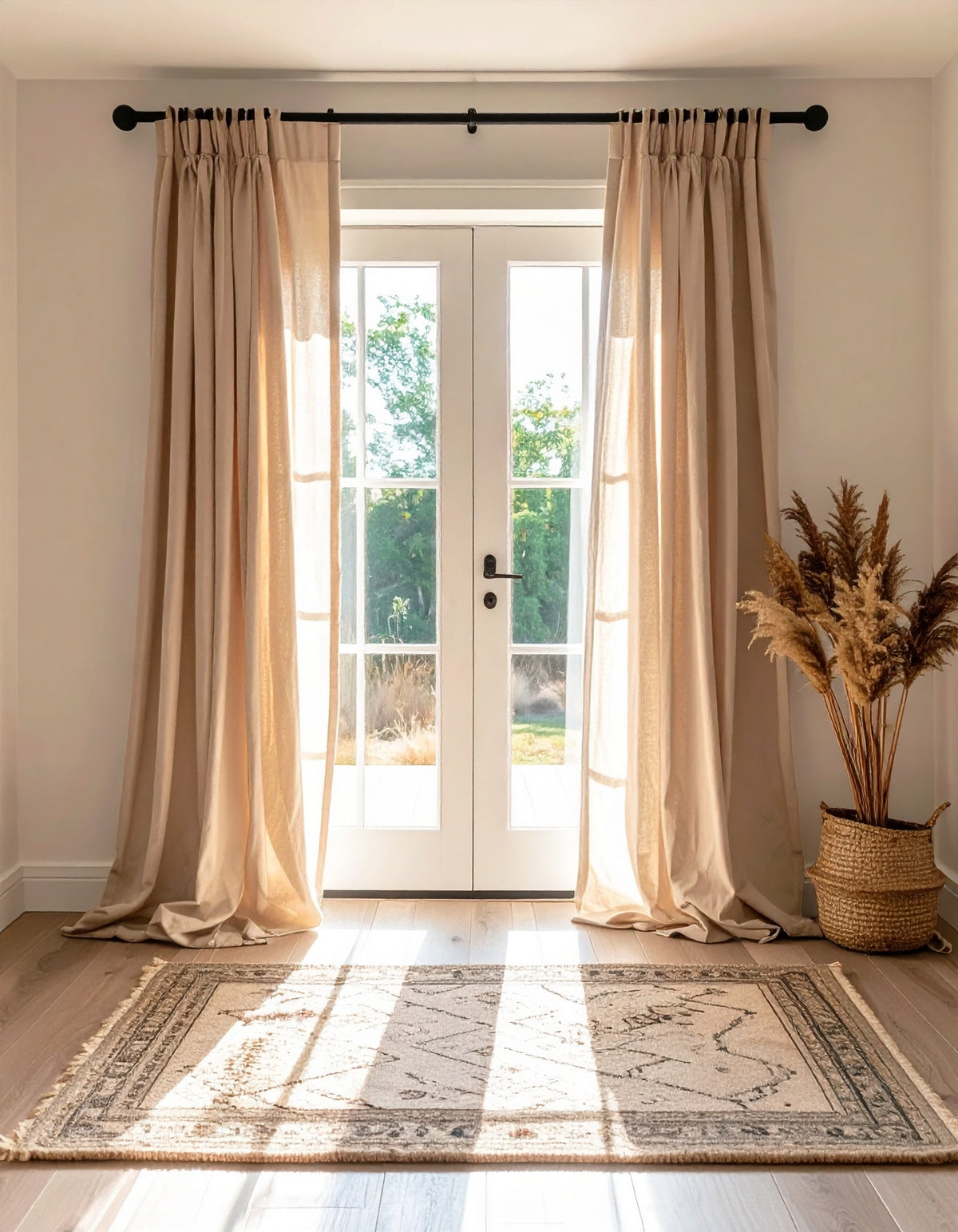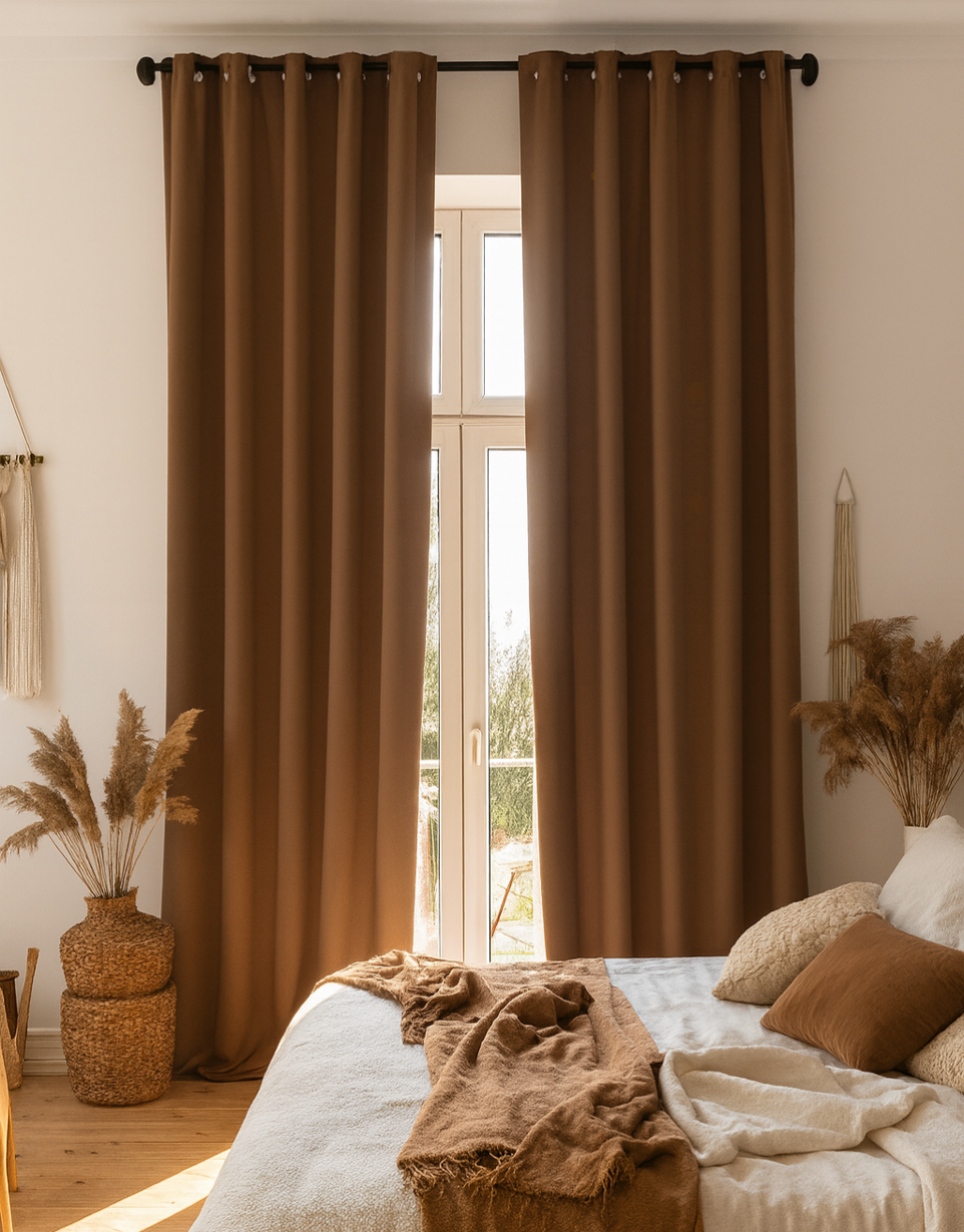How curtains hang can change the feel of a room just as much as the fabric or color. The way they drape, gather or glide can make your space feel airy, cozy, elegant or modern.
Every fold, pleat or ripple tells a story of care and intention, and your home deserves nothing less. Let’s explore some of the most popular ways to hang curtains, so you can find the style that feels fitting for your home.
Rod Pocket
A classic, understated style. The curtain has a sewn-in pocket at the top through which the rod slips. Rod pocket curtains create soft, gentle folds and a relaxed, seamless look. They work beautifully for lightweight fabrics and rooms where a cozy, flowing feel is desired.

Eyelet / Grommet
Eyelet curtains have large metal rings at the top, sliding along the rod. They create wide, even folds that are easy to open and close. The spacing of eyelets can adjust fullness: closer spacing creates richer folds, while wider spacing gives a more relaxed, contemporary effect. Eyelets work especially well with heavier fabrics or patterned curtains. The spacing of the rings affects the fullness, so closer rings create a richer, more tailored look.

Tab Top
Tabs of fabric loop over the rod, offering a casual, airy feel. This style works best with lightweight curtains and adds simplicity and charm, as if the curtains are naturally resting in place rather than being structured. We recommend choosing a slightly thicker rod to prevent sagging and keep the tabs evenly spaced for a neat appearance.

Pleated Hooks (Pinch Pleat, Euro Pleat, Box Pleat, Pencil Pleat)
Pleated styles gather fabric at the top in tailored folds.
-
Pinch Pleat: Small, neat folds pinched together at the top, creating soft, evenly spaced waves. This style offers subtle movement and is ideal for living rooms or bedrooms where a gentle drape is desired. It works beautifully with medium-weight fabrics like cotton, linen or light velvet.
-
Euro Pleat: Wider and slightly more formal than pinch pleats. The larger folds create a stately presence, which makes them perfect for dining rooms, home offices or entryways.
-
Box Pleat: Pleats are evenly spaced and structured and form a crisp, architectural silhouette. Box pleats work well with heavier fabrics like silk, velvet or lined drapes. They are especially effective in spaces with high ceilings or formal décor.
-
Pencil Pleat: Pleats are narrower, closely gathered and create a soft, classic drape that resembles a row of pencils. Pencil pleats work well with lighter to medium-weight fabrics such as cotton, linen or sheers. They are especially effective when you want a fuller, more textured curtain finish.

Tips for Pleated Curtains:
-
Pleated curtains are ideal when you want a timeless, elegant look that complements traditional or modern interiors alike. We suggest adjusting fullness (2x is ideal) to achieve charming folds without overpowering the space.
-
2.5x fullness gives a more luxurious, dramatic fold that’s perfect for statement curtains or layered window treatments.
-
Pair pleated curtains with sheers for layered versatility or combine with tiebacks to control light while highlighting the folds.
Wave Heading
Wave curtains create smooth, continuous folds that ripple from top to bottom. They glide effortlessly along tracks or rods, giving a sense of calm and movement. This style is perfect for minimalist or contemporary spaces, offering a quiet sophistication while softening the light naturally.

Track System
Curtains on a track glide silently and smoothly, which makes them perfect for larger windows or spaces where opening and closing frequently is important. Tracks can be mounted on ceilings or walls, allowing curtains to hang straight and flow gracefully without interruption. You can consider ceiling-mounted tracks for a “floor-to-ceiling” effect to elongate the room visually.

Choosing the Heading Style
Your curtain heading sets the tone for the room. Before choosing the right heading style, think about the function of the room, how often curtains will be drawn and the visual impact you want to create. In high-traffic areas, glide-friendly styles like eyelet or wave headings are practical. In decorative or formal spaces, pleated curtains offer richness and dimension. Also, think about the mood you want your windows to set. Would you want them to feel warm and cozy, elegantly refined or light and effortless? In the end, there’s no single “right” style, only the one that feels like home to you.









2 comments
76b7lr
76b7lr